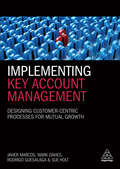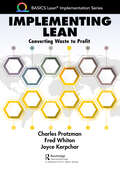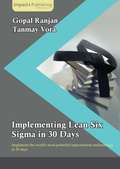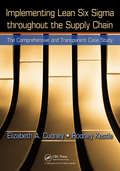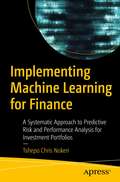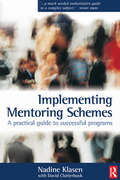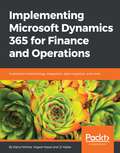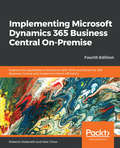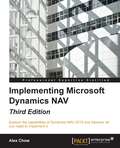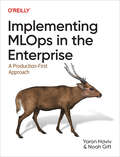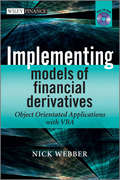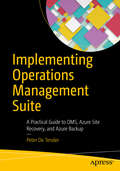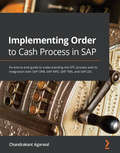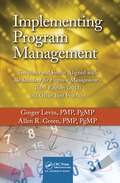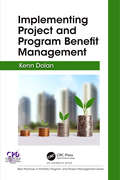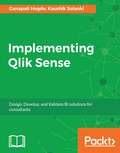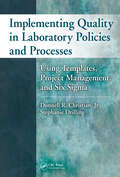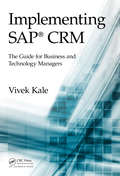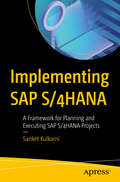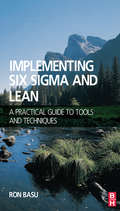- Table View
- List View
Implementing IT Processes
by Lionel PilorgetInformation Technology plays a major role in our society. Due to system integration and process automation, a company has to rely on performant information systems. To achieve this objective, it is important to have relevant IT processes in place on the one hand to ensure current operation and on the other hand to enable the successful introduction of new technologies. Once IT processes are defined and described, interrelations become visible, which allow to gain an appropriate level of maturity.
Implementing Key Account Management: Designing Customer-Centric Processes for Mutual Growth
by Dr Javier Marcos Mark Davies Dr Rodrigo Guesalaga Dr Sue HoltImplementing Key Account Management is a highly practical handbook that guides readers through the realities of rolling out a functional key account management programme. The book offers an integrated framework for key account management (KAM) that businesses can use to design or further develop strategic customer management programmes, enabling them to overcome the obstacles that organizations often face when rolling out their strategies. Bringing together the experiences of leading experts within this field, Implementing Key Account Management draws on two decades of research and best practice from Cranfield University School of Management, one of the foremost centres for researcher and thought leadership in KAM. Between them, the authors have designed and delivered programmes globally for clients such as Rolls-Royce, Unilever, Vodafone, The Economist and many more. Rigorously researched, well-grounded and practical, this book is - quite simply - the definitive, go-to resource for implementing key account management programmes.
Implementing Lean: Twice the Output with Half the Input!
by Charles W. Protzman Fred Whiton Daniel ProtzmanEveryone has heard the phrase about doing twice the work in half the time, but instead of focusing only on time, this book focuses on driving increased output with consistently less input. Implementing Lean: Twice the Output with Half the Input! teaches readers not only about Lean and its major concepts, but it drives the leader toward implementing a true Lean system. The authors have used the methodologies in this book everywhere from hospitals to service industries to manufacturing plants in order to impact businesses by providing proven principles, techniques, and approaches that yield substantial improvement to any business, small or large, in any sector. Learn about the benefits of implementing Lean in your company as the authors walk you through the major components as well as show you how to implement them. This guide is already being used by Lean Practitioners every day on shop floors to educate and refresh how tools are used in real-world applications.
Implementing Lean: Converting Waste to Profit (BASICS Lean® Implementation)
by Charles Protzman Fred Whiton Joyce KerpcharLean is about building and improving stable and predictable systems and processes to deliver to customers high-quality products/services on time by engaging everyone in the organization. Combined with this, organizations need to create an environment of respect for people and continuous learning. It’s all about people. People create the product or service, drive innovation, and create systems and processes, and with leadership buy-in and accountability to ensure sustainment with this philosophy, employees will be committed to the organization as they learn and grow personally and professionally. Lean is a term that describes a way of thinking about and managing companies as an enterprise. Becoming Lean requires the following: the continual pursuit to identify and eliminate waste; the establishment of efficient flow of both information and process; and an unwavering top-level commitment. The concept of continuous improvement applies to any process in any industry. Based on the contents of The Lean Practitioners Field Book, the purpose of this series is to show, in detail, how any process can be improved utilizing a combination of tasks and people tools and introduces the BASICS Lean® concept. The books are designed for all levels of Lean practitioners and introduces proven tools for analysis and implementation that go beyond the traditional point kaizen event. Each book can be used as a stand-alone volume or used in combination with other titles based on specific needs. Each book is chock-full of case studies and stories from the authors’ own experiences in training organizations that have started or are continuing their Lean journey of continuous improvement. Contents include valuable lessons learned and each chapter concludes with questions pertaining to the focus of the chapter. Numerous photographs enrich and illustrate specific tools used in Lean methodology. Implementing Lean: Converting Waste to Profit explores implementation methods, line balancing methods, including baton zone or bumping, and implementing Lean in the office and machine shops. The goal of this book is to introduce the balance of the tools and how to proceed once the analysis is completed. There are many pieces to a Lean implementation and all of them are interconnected. This book walks through the relationships and how the data presented can be leveraged to prepare for the implementation. It also provides suggest solutions for improvements and making recommendations to management to secure their buy-in and approval.
Implementing Lean Six Sigma in 30 Days
by Gopal Ranjan Tanmay VoraThis book is for anyone motivated and driven by the desire to create improvements within their team or wider business.
Implementing Lean Six Sigma throughout the Supply Chain: The Comprehensive and Transparent Case Study
by Elizabeth A. Cudney Rodney KestleExplanations of theory, lists of rules, and discussions of procedure are the basis of learning the lean Six Sigma, however without a visceral understanding of the application of this powerful system in various circumstances the knowledge remains, at best, conjecture. Detailed examination of case studies that take real-world variables into account is the only way to truly master Lean Six Sigma.Providing a comprehensive Lean Six Sigma case study from start to finish, Implementing Lean Six Sigma throughout the Supply Chain: The Comprehensive and Transparent Case Study employs the Define—Measure—Analyze—Improve—Control (DMAIC) process used in today’s retail industry. Going far beyond the brief overview found in current texts, this interactive case study presents all of the data used by a team as they implement Lean Six Sigma in a distribution center. It details their decision-making rational, thus allowing the reader to extrapolate and implement the same analyses and conclusions in their own settings.The downloadable resources contain all of the numerous graphs, charts, tables, and data analyses provided in the text. It provides PowerPoint training slides and easily accessible data sets that correspond to the figures in the book, as well as a full Glossary and reference guide to commonly used Lean and Six Sigma terms.Providing a clear link between all of the Lean Six Sigma tools and their application in a real-world setting, indispensible training tool gives the all-important, rubber-meets-the-road understanding needed to start you on your Lean Six Sigma journey.
Implementing Machine Learning for Finance: A Systematic Approach to Predictive Risk and Performance Analysis for Investment Portfolios
by Tshepo Chris NokeriBring together machine learning (ML) and deep learning (DL) in financial trading, with an emphasis on investment management. This book explains systematic approaches to investment portfolio management, risk analysis, and performance analysis, including predictive analytics using data science procedures.The book introduces pattern recognition and future price forecasting that exerts effects on time series analysis models, such as the Autoregressive Integrated Moving Average (ARIMA) model, Seasonal ARIMA (SARIMA) model, and Additive model, and it covers the Least Squares model and the Long Short-Term Memory (LSTM) model. It presents hidden pattern recognition and market regime prediction applying the Gaussian Hidden Markov Model. The book covers the practical application of the K-Means model in stock clustering. It establishes the practical application of the Variance-Covariance method and Simulation method (using Monte Carlo Simulation) for value at risk estimation. It also includes market direction classification using both the Logistic classifier and the Multilayer Perceptron classifier. Finally, the book presents performance and risk analysis for investment portfolios.By the end of this book, you should be able to explain how algorithmic trading works and its practical application in the real world, and know how to apply supervised and unsupervised ML and DL models to bolster investment decision making and implement and optimize investment strategies and systems.What You Will LearnUnderstand the fundamentals of the financial market and algorithmic trading, as well as supervised and unsupervised learning models that are appropriate for systematic investment portfolio managementKnow the concepts of feature engineering, data visualization, and hyperparameter optimizationDesign, build, and test supervised and unsupervised ML and DL modelsDiscover seasonality, trends, and market regimes, simulating a change in the market and investment strategy problems and predicting market direction and pricesStructure and optimize an investment portfolio with preeminent asset classes and measure the underlying riskWho This Book Is ForBeginning and intermediate data scientists, machine learning engineers, business executives, and finance professionals (such as investment analysts and traders)
Implementing Mentoring Schemes
by David Clutterbuck Nadine KlasenOver the past few years the application of mentoring in business has risen steeply and more organizations than ever are seeking to utilize its power. 'Implementing Mentoring Schemes' constitutes the most comprehensive and up-to-date coverage of the design, implementation, evaluation and revitalization of mentoring schemes. Although it can be used as a practical "how-to" guide on implementing mentoring schemes, it is ultimately a book that promotes best practice, combining academic research and case studies with many years of practical experience to produce expert advice. It enables readers to fully understand mentoring and to create state-of-the-art programs. In addition, it establishes a tenable case for mentoring that will greatly assist readers in promoting programs within their organization.
Implementing Microsoft Dynamics 365 for Finance and Operations
by Rahul Mohta Yogesh Kasat Jj YadavHarness the power of Dynamics 365 Operations and discover all you need to implement it About This Book • Master all the necessary tools and resources to evaluate Dynamics 365 for Operations, implement it, and proactively maintain it. • Troubleshoot your problems effectively with your Dynamics 365 partner • Learn about architecture, deployment choices, integration, configuration and data migration, development, testing, reporting and BI, support, upgrading, and more. Who This Book Is For This book is for technology leaders, project managers solution architects, and consultants who are planning to implement, are in the process of implementing, or are currently upgrading to Dynamics 365 for Operations. This book will help you effectively learn and implement Dynamics 365 for Operations. What You Will Learn • Learn about Microsoft Dynamics 365, it's offerings, plans and details of Finance and Operations, Enterprise edition • Understand the methodology and the tool, architecture, and deployment options • Effectively plan and manage configurations and data migration, functional design, and technical design • Understand integration frameworks, development concepts, best practices, and recommendations while developing new solutions • Learn how to leverage intelligence and analytics through Power BI, machine learning, IOT, and Cortana intelligence • Master testing, training, going live, upgrading, and how to get support during and after the implementation In Detail Microsoft Dynamics 365 for Finance and Operations, Enterprise edition, is a modern, cloud-first, mobile-first, ERP solution suitable for medium and large enterprise customers. This book will guide you through the entire life cycle of a implementation, helping you avoid common pitfalls while increasing your efficiency and effectiveness at every stage of the project. Starting with the foundations, the book introduces the Microsoft Dynamics 365 offerings, plans, and products. You will be taken through the various methodologies, architectures, and deployments so you can select, implement, and maintain Microsoft Dynamics 365 for Finance and Operations, Enterprise edition. You will delve in-depth into the various phases of implementation: project management, analysis, configuration, data migration, design, development, using Power BI, machine learning, Cortana analytics for intelligence, testing, training, and finally deployment, support cycles, and upgrading. This book focuses on providing you with information about the product and the various concepts and tools, along with real-life examples from the field and guidance that will empower you to execute and implement Dynamics 365 for Finance and Operations, Enterprise edition. Style and approach This book is a step-by-step guide focusing on implementing Dynamics 365 Operations solutions for your organization.
Implementing Microsoft Dynamics 365 for Finance and Operations Apps: Learn best practices, architecture, tools, techniques, and more, 2nd Edition
by Yogesh Kasat Rahul Mohta JJ Yadav Sandeep ShuklaHarness the power of Finance and Operations apps, and discover all you need for their implementation Key Features Manage and plan different Dynamics configurations, designs, and products Learn how to manage projects for pre-sales and implementation using Microsoft Dynamics Lifecycle Services (LCS) Discover various integration planning techniques, tools, and frameworks such as PowerApps and Power Automate Book Description Microsoft Dynamics 365 for Finance and Operations is a modern cloud ERP platform that adopts a mobile-first approach suitable for medium-to-large enterprises. This book covers the entire implementation process of Dynamics 365 Finance and Operation Apps, including post-implementation and business transformation. The updated second edition starts with an introduction to Microsoft Dynamics 365, describing different apps and tools under it. You will learn about different implementation methodologies such as Waterfall and Agile, for your projects. We will cover various application components and architectures of Dynamics such as requirements processing, development, reports and analytics, and integration. With the help of tips, techniques, and best practices, you'll explore strategies for managing configurations and data migrations. As you read further, you'll discover development tools and processes in Dynamics for building customized solutions in Dynamics. The book will also demonstrate analytics and financial reporting options such as Power BI and Cortana Intelligence. Finally, you'll learn the importance of testing and explore various automated testing strategies. By the end of this book, you will have gained the necessary knowledge to implement Microsoft business solutions with Dynamics 365 for Finance and Operations Apps. What you will learn Understand the architecture of Dynamics 365 for Finance and Operations Apps Implement Dynamics with confidence to manage finances in your business Get up to speed with different methodologies and support cycles of the Microsoft Dynamics architecture Explore best practices to analyze the requirements of your business Understand the technique of data migration from legacy systems Leverage the capabilities of Power BI to make informed business decisions Manage all your upgrades through One Version service updates Who this book is for This book is for consultants, technical managers, project managers, or solution architects who are looking to implement Microsoft Dynamics 365 Finance and Operations apps in their business. A basic understanding of the enterprise resource planning (ERP) implementation process and software lifecycle is expected.
Implementing Microsoft Dynamics NAV and Business Central - Fourth Edition
by Roberto Stefanetti Alex ChowThis book is for Dynamics NAV partners and end users who want to know everything about Dynamics NAV implementations. It is aimed at those who want to be project managers or get involved with Dynamics NAV, but do not have the expertise to write code themselves. This book can be useful to understand the need to move to Business Central.
Implementing Microsoft Dynamics NAV - Third Edition
by Alex ChowExplore the capabilities of Dynamics NAV 2016 and discover all you need to implement it About This Book * Learn the key roles of your Dynamics NAV partner and the roles within your customer's organization * Create configuration packages and perform data migration on your own * Find out how to troubleshoot your problems effectively with your Dynamics NAV partner Who This Book Is For This book is for Dynamics NAV partners and end users who want to know everything about Dynamics NAV implementations. It is aimed at those who want to be project managers or get involved with Dynamics NAV, but do not have the expertise to write code themselves. What You Will Learn * Study the roles within a Dynamics NAV partner and within a customer's company * Create reusable data migration packages * Work with the debugger to pinpoint error messages * Get to grips with the key tables used in data reporting and analysis * Successfully upgrade your installation to the latest version * Manage and expand your existing installation with additional functionalities * Explore the free third-party add-ons that can leverage your existing installation In Detail Microsoft Dynamics NAV 2013 is an Enterprise Resource Planning (ERP) application used in all kinds of organizations around the world. It provides a great variety of functionality out-of-the-box in different topics such as accounting, sales, purchase processing, logistics, or manufacturing. It also allows companies to grow the application by customizing the solution to meet specific requirements. This book is a hands-on tutorial on working with a real Dynamics NAV implementation. You will learn about the team from your Microsoft Dynamics NAV partner as well as the team within the customer's company. This book provides an insight into the different tools available to migrate data from the client's legacy system into Microsoft Dynamics NAV. If you are already live with Microsoft Dynamics NAV, this books talks about upgrades and what to expect from them. We'll also show you how to implement additional or expanding functionalities within your existing Microsoft Dynamics NAV installation, perform data analysis, debug error messages, and implement free third-party add-ons to your existing installation. This book will empower you with all the skills and knowledge you need for a successful implementation. Style and approach This book is step-by-step guide to implementing Dynamics NAV from start to finish.
Implementing MLOps in the Enterprise: A Production-First Approach
by Yaron Haviv Noah GiftWith demand for scaling, real-time access, and other capabilities, businesses need to consider building operational machine learning pipelines. This practical guide helps your company bring data science to life for different real-world MLOps scenarios. Senior data scientists, MLOps engineers, and machine learning engineers will learn how to tackle challenges that prevent many businesses from moving ML models to production.Authors Yaron Haviv and Noah Gift take a production-first approach. Rather than beginning with the ML model, you'll learn how to design a continuous operational pipeline, while making sure that various components and practices can map into it. By automating as many components as possible, and making the process fast and repeatable, your pipeline can scale to match your organization's needs.You'll learn how to provide rapid business value while answering dynamic MLOps requirements. This book will help you:Learn the MLOps process, including its technological and business valueBuild and structure effective MLOps pipelinesEfficiently scale MLOps across your organizationExplore common MLOps use casesBuild MLOps pipelines for hybrid deployments, real-time predictions, and composite AIBuild production applications with LLMs and Generative AI, while reducing risks, increasing the efficiency, and fine tuning modelsLearn how to prepare for and adapt to the future of MLOpsEffectively use pre-trained models like HuggingFace and OpenAI to complement your MLOps strategy
Implementing Models of Financial Derivatives
by Nick WebberImplementing Models of Financial Derivatives is a comprehensive treatment of advanced implementation techniques in VBA for models of financial derivatives. Aimed at readers who are already familiar with the basics of VBA it emphasizes a fully object oriented approach to valuation applications, chiefly in the context of Monte Carlo simulation but also more broadly for lattice and PDE methods. Its unique approach to valuation, emphasizing effective implementation from both the numerical and the computational perspectives makes it an invaluable resource. The book comes with a library of almost a hundred Excel spreadsheets containing implementations of all the methods and models it investigates, including a large number of useful utility procedures. Exercises structured around four application streams supplement the exposition in each chapter, taking the reader from basic procedural level programming up to high level object oriented implementations. Written in eight parts, parts 1-4 emphasize application design in VBA, focused around the development of a plain Monte Carlo application. Part 5 assesses the performance of VBA for this application, and the final 3 emphasize the implementation of a fast and accurate Monte Carlo method for option valuation. Key topics include: ?Fully polymorphic factories in VBA;?Polymorphic input and output using the TextStream and FileSystemObject objects;?Valuing a book of options;?Detailed assessment of the performance of VBA data structures;?Theory, implementation, and comparison of the main Monte Carlo variance reduction methods;?Assessment of discretization methods and their application to option valuation in models like CIR and Heston;?Fast valuation of Bermudan options by Monte Carlo. Fundamental theory and implementations of lattice and PDE methods are presented in appendices and developed through the book in the exercise streams. Spanning the two worlds of academic theory and industrial practice, this book is not only suitable as a classroom text in VBA, in simulation methods, and as an introduction to object oriented design, it is also a reference for model implementers and quants working alongside derivatives groups. Its implementations are a valuable resource for students, teachers and developers alike. Note: CD-ROM/DVD and other supplementary materials are not included as part of eBook file.
Implementing Operations Management Suite
by Peter De TenderLearn how to protect, back up, recover, and monitor your data and infrastructure in the cloud with Microsoft's Operations Management Suite (OMS), Azure Backup, and Azure Site Recovery.Implementing Operations Management Suite starts with an overview of the Operations Management Suite, followed by an introduction to Azure virtual machines and virtual networks. Chapters cover Azure Backup and how to configure it, followed by deep dives into aspects of Azure Site Recovery (ASR): how it works, how to configure it, how to streamline your disaster recovery failover from on-premises to Azure, and so on. Learn about protection groups, how to perform planned and unplanned failover, and more. Windows IT pro consultant, trainer and MVP Peter De Tender takes you through the necessary theory and background on each topic along with hands-on step-by-step lab guides to help you implement and configure each feature for yourself. You’ll also find out how to estimate your platform costs when using Azure infrastructure components, making this book your one-stop guide to the latest disaster recovery services in Microsoft Azure. What You'll LearnUnderstand current concepts and challenges in IT disaster recoveryGet introduced to Microsoft Azure, Azure virtual networks and Azure virtual machinesProtect your data in the cloud with Azure Backup, and the configuration options availableUnderstand how to protect, recover, and monitor your environment with Azure Site Recovery Manager, and the configuration options availableExtend Azure Site Recovery Manager to non-Hyper-V workloadsWho This Book Is ForIT professionals and IT decision makers who are interested in learning about Azure backup and Azure Site Recovery Manager in order to build and/or optimize their IT disaster recovery scenarios.
Implementing Order to Cash Process in SAP: An end-to-end guide to understanding the OTC process and its integration with SAP CRM, SAP APO, SAP TMS, and SAP LES
by Chandrakant AgarwalImplement critical business processes with mySAP Business Suite to integrate key functions that add value to every facet of your organizationKey FeaturesLearn master data concepts and UI technologies in SAP systemsExplore key functions of different sales processes, order fulfillment options, transportation planning, logistics execution processes, and customer invoicingConfigure the Order to Cash process in SAP systems and apply it to your business needsBook DescriptionUsing different SAP systems in an integrated way to gain maximum benefits while running your business is made possible by this book, which covers how to effectively implement SAP Order to Cash Process with SAP Customer Relationship Management (CRM), SAP Advanced Planning and Optimization (APO), SAP Transportation Management System (TMS), SAP Logistics Execution System (LES), and SAP Enterprise Central Component (ECC). You'll understand the integration of different systems and how to optimize the complete Order to Cash Process with mySAP Business Suite. With the help of this book, you'll learn to implement mySAP Business Suite and understand the shortcomings in your existing SAP ECC environment. As you advance through the chapters, you'll get to grips with master data attributes in different SAP environments and then shift focus to the Order to Cash cycle, including order management in SAP CRM, order fulfillment in SAP APO, transportation planning in SAP TMS, logistics execution in SAP LES, and billing in SAP ECC. By the end of this SAP book, you'll have gained a thorough understanding of how different SAP systems work together with the Order to Cash process. What you will learnDiscover master data in different SAP environmentsFind out how different sales processes, such as quotations, contracts, and order management, work in SAP CRMBecome well-versed with the steps involved in order fulfillment, such as basic and advanced ATP checks in SAP APOGet up and running with transportation requirement and planning and freight settlement with SAP TMSExplore warehouse management with SAP LES to ensure high transparency and predictability of processesUnderstand how to process customer invoicing with SAP ECCWho this book is forThis book is for SAP consultants, SME managers, solution architects, and key users of SAP with knowledge of end-to-end business processes. Customers operating SAP CRM, SAP TMS, and SAP APO as part of daily operations will also benefit from this book by understanding the key capabilities and integration touchpoints. Working knowledge of SAP ECC, SAP CRM, SAP APO, SAP TMS, and SAP LES is necessary to get started with this book.
Implementing Patient Safety: Addressing Culture, Conditions and Values to Help People Work Safely
by Suzette WoodwardOver the last two decades across the globe we have seen a multitude of programs, projects and books to help improve the safety of patient care in healthcare. However, the full potential of these has not yet been reached. Most of the current approaches are top down, programmatic and target driven. These look at problems in isolation one harm at a time with simplistic solutions that fail to support a holistic, systematic approach. They are focused on collecting incident data and learning from failure using tools that are not fit for purpose in a complex nonlinear system. Very rarely do the solutions help build the conditions, cultures and behaviours that support a safer system and help the people involved work safely. Healthcare is stuck in a relentlessly negative approach to safety. Those working in patient safety and healthcare are struggling, and books on patient safety to date instruct the reader to continue doing the same things we have been doing for the last 20 years. This book uniquely combines the latest thinking in safety, including creating a balanced approach to learning from what works as a way to understand why it fails, together with the evidence on building a just culture, positive workplaces and working relationships that we now know are so important for safety. It helps people understand how to address issues despite their complexities and improve safety with practical ways to truly understand what day to day healthcare work is actually like, rather than what people imagine it is like. This book builds on the author’s first book Rethinking Patient Safety which exposed what we need to do differently to truly transform our approach to patient safety. It updates the reader further on the concepts explored in the first book but also vitally helps readers understand the ‘how’. Implementing Patient Safety goes beyond the rhetoric and provides the reader with ideas and examples for how the latest thinking can actually be achieved. It is based on the author’s personal experience of leading a national culture change campaign in the National Health Service for five years. The lessons arise from helping hundreds of organisations and people rethink and implement a whole new way of thinking about improving patient safety in healthcare.
Implementing Program Management: Templates and Forms Aligned with the Standard for Program Management, Third Edition (2013) and Other Best Practices (Best Practices And Advances In Program Management Ser. #6)
by Ginger Levin Allen R. GreenSuccess in program management requires discipline, complete plans, well-run meetings, accurate record keeping, and adherence to global best practices. Implementing Program Management: Templates and Forms Aligned with the Standard for Program Management, Third Edition (2013) and Other Best Practices provides the templates and guidelines for the plan
Implementing Project and Program Benefit Management (Best Practices in Portfolio, Program, and Project Management)
by Kenn DolanOne of the most difficult, yet important, questions regarding projects is "What advantages will this project create for the investors and key stakeholders?" Projects and programs should be treated as investments. This means that the focus of projects shifts from delivering within the triple constraints (time–cost–quality) towards some of the more fundamental questions: <P><P> <li>What is the purpose of this investment? <li>What are the specific advantages expected? <li>Are these benefits worth the investment? <P><P>Implementing Project and Program Benefit Management is written for executives and practitioners within the portfolio, program, and project environment. It guides them through the important work that must be addressed as the investment progresses towards the realization of benefits. The processes discussed cover the strategic elements of benefits realization as well as the more detailed requirements, which are the domain of the program delivery teams and the operational users. Using real cases to explain complex situations, operational teams and wider groups of stakeholders, including communities affected by infrastructure projects, will be able to engage in the conversation with the sponsors and delivery teams. <P><P>Covering an area of program and project management that is rapidly becoming more widely valued, this book blends theory with practical experience to present a clear process flow to managing the benefits life cycle. Best practices are defined, and pitfalls and traps are identified to enable practitioners to apply rigor and structure to this crucial discipline.
Implementing Qlik Sense
by Ganapati Hegde Kaushik SolankiBecome a full-fledged Qlik Sense Consultant with the help of this unique guide About This Book • Become a successful Qlik consultant with the help of this insightful guide • Build what is in line as well as exceeding your customer's expectations from your Qlik Sense solutions using this highly practical guide • Build result-driven optimized BI solutions using Qlik with the help of industry examples Who This Book Is For If you have basic familiarity with Qlik Sense and want to upgrade your skills to become a full-fledged Qlik Consultant, this book is for you. With this book, you will be able to create efficient business intelligence solutions that would fetch client satisfaction, and in turn, more projects. What You Will Learn • Understand the importance and expectations of a consultant's role • Engage with the customer to understand the ir goals and future objectives • Design the optimum architecture, using the best practices for the development and implementation of your projects • Ensure successful adoption using real-life examples to make your learning complete • Learn about the important stages of a Qlik project's life cycle In Detail Qlik Sense is a leading platform for business intelligence (BI) solutions. Qlik Sense helps organizations in making informed decisions based on the data they have. This book will teach you how to effectively use Qlik for optimum customer satisfaction. You will undergo a metamorphosis from a developer to a consultant who is capable of building the most suitable BI solutions for your clients. The book will take you through several business cases – this will give you enough insight to understand the needs of the client clearly and build a BI solution that meets or exceeds their expectations. Starting from the pre-project activities, you will go to the actual execution of the project, the implementation, and even maintenance. This book will give you all the information you need - from the strategy to requirement gathering to implementing BI solutions using Qlik Sense. The book will empower you to take the right decisions in tricky and diffi cult situations while developing analytics and dashboards. Style and approach This book will be a hands-on guide that will teach you all the what-to-do's, when-to-do's, and how-to-do's for becoming a successful Qlik Sense Consultant. With the help of various business scenarios, the book will cover real-world problems that you can relate to. Various solutions in the book will be backed up by the thought process of why are these solutions used and how you can implement them in your own business environment.
Implementing Quality in Laboratory Policies and Processes: Using Templates, Project Management, and Six Sigma
by Donnell R. Christian Jr. Stephanie DrillingIn order to gain accreditation, every laboratory must have a superior quality assurance program. The keys to a successful program are the operational and technical manuals and associated documents which define the program and its various components. Written by experts with global experience in setting up laboratories, Implementing Quality in Labora
Implementing SAP CRM: The Guide for Business and Technology Managers
by Vivek KaleIn today's competitive business environment, most companies realize that the better they can manage their customer relationships, the more successful they will become. Customer Relationship Management (CRM) software systems are key tools for companies to manage the customer-facing processes of their businesses. However, many companies have resisted
Implementing SAP S/4HANA: A Framework for Planning and Executing SAP S/4HANA Projects
by Sanket KulkarniGain a better understanding of implementing SAP S/4HANA-based digital transformations. This book helps you understand the various components involved in the planning and execution of successful SAP S/4HANA projects. Learn how to ensure success by building a solid business case for SAP S/4HANA up front and track business value generated throughout the implementation. Implementing SAP S/4HANA provides a framework for planning and executing SAP S/4HANA projects by articulating the implementation approach used by different components in SAP S/4HANA implementations. Whether you are mid-way through the SAP S/4HANA program or about to embark on it, this book will help you throughout the journey. If you are looking for answers on why SAP S/4HANA requires special considerations as compared to a traditional SAP implementation, this book is for you.What You Will LearnUnderstand various components of your SAP S/4HANA projectForecast and track your success throughout the SAP S/4HANA implementationBuild a solid business case for your SAP S/4HANA programDiscover how the implementation approach varies across these componentsWho This Book Is ForSAP S/4HANA clients (line managers and consultants).
Implementing Service Quality based on ISO/IEC 20000
by Michael KunasAn up-to-date, practical guide for implementation and certification under ISO/IEC 20000ISO/IEC 20000 is an important international standard for IT service providers. Implementation and certification will improve your business processes and practices. It will reassure your customers that your company is efficient, reliable and trustworthy. Customers will return because they know from experience that your service is second to none. Customer confidence means more businessPotential customers will look for suppliers with ISO/IEC 20000 certification, seeking the reassurance it provides. This book will guide you through implementation and certification. Your streamlined management processes will enable you to offer first-class customer service at competitive prices. The impact on your profit margins is clear! Step by step to successful implementationThis step-by-step management guide will benefit all who have a role in the implementation and certification process. Written for companies of any size in any location, it: gives a clear and detailed breakdown of the 2011 edition of the Standard identifies the role of ISO/IEC 20000 and other related standards, as well as ITIL and COBIT and the relationship between them explains what is really meant by 'quality' establishes the importance of a service management system and gives practical recommendations for its implementation tells you how to prepare for audit, including carrying out a Gap Analysis offers an explanation of the individual processes outlined in the Standard and gives clear guidelines for their implementation.
Implementing Six Sigma and Lean
by Ron BasuThis is a comprehensive, user-friendly and hands-on book that is a single source of reference of tools and techniques for all quality practitioners. Implementing Six Sigma and Lean covers the basics of how to manage for consistently high quality and gives good coverage of both simple tools and advanced techniques which can be used in all businesses. This book provides guidance on how to use these tools for different situations such as new start-up companies, stalled projects and the constant achievement of high quality in well-established quality regimes.Case studies are included that encourage the reader to respond in a practical situations and provide a good learning resource for courses. There are summaries of key elements and questions with exercises at the end of each chapter.

